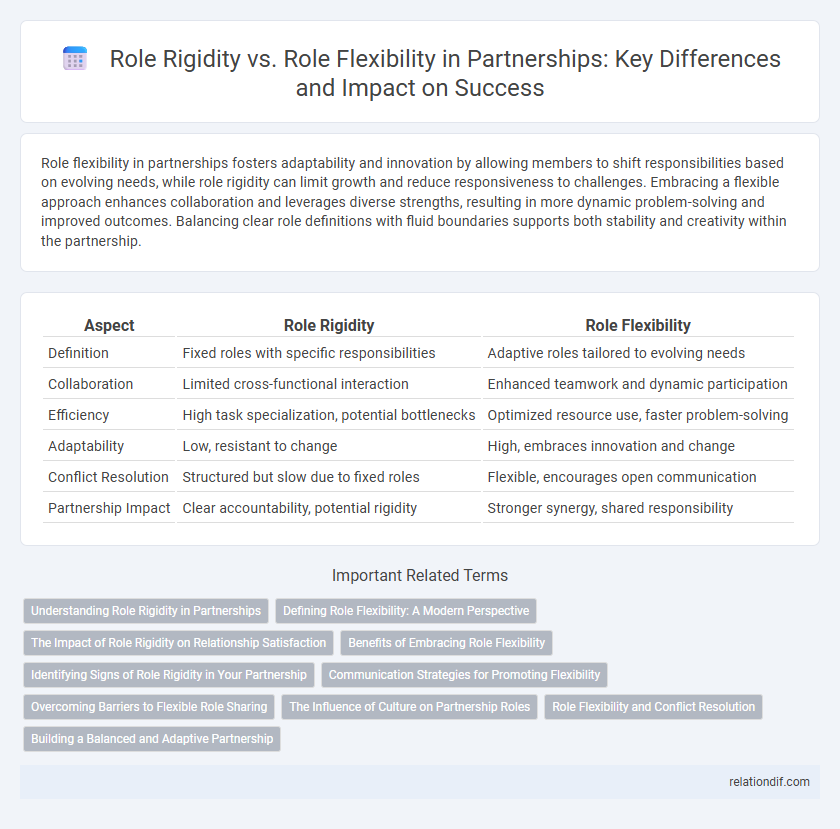Role flexibility in partnerships fosters adaptability and innovation by allowing members to shift responsibilities based on evolving needs, while role rigidity can limit growth and reduce responsiveness to challenges. Embracing a flexible approach enhances collaboration and leverages diverse strengths, resulting in more dynamic problem-solving and improved outcomes. Balancing clear role definitions with fluid boundaries supports both stability and creativity within the partnership.
Table of Comparison
| Aspect | Role Rigidity | Role Flexibility |
|---|---|---|
| Definition | Fixed roles with specific responsibilities | Adaptive roles tailored to evolving needs |
| Collaboration | Limited cross-functional interaction | Enhanced teamwork and dynamic participation |
| Efficiency | High task specialization, potential bottlenecks | Optimized resource use, faster problem-solving |
| Adaptability | Low, resistant to change | High, embraces innovation and change |
| Conflict Resolution | Structured but slow due to fixed roles | Flexible, encourages open communication |
| Partnership Impact | Clear accountability, potential rigidity | Stronger synergy, shared responsibility |
Understanding Role Rigidity in Partnerships
Role rigidity in partnerships often leads to limited collaboration and stifled innovation, as fixed roles restrict adaptability and responsiveness to changing circumstances. Understanding role rigidity involves recognizing how strict adherence to defined responsibilities can create communication barriers and reduce the potential for synergy between partners. Emphasizing flexibility allows partnerships to leverage diverse skills and dynamically adjust roles to meet evolving objectives and challenges.
Defining Role Flexibility: A Modern Perspective
Role flexibility in partnerships embodies adaptive behavior where individuals transcend traditional role boundaries to address evolving challenges and leverage diverse skills. Emphasizing dynamic role allocation enhances collaboration, innovation, and responsiveness within teams. Modern organizational theories highlight role flexibility as a critical driver for sustaining competitive advantage and fostering resilient partnerships.
The Impact of Role Rigidity on Relationship Satisfaction
Role rigidity in partnerships often leads to decreased relationship satisfaction due to limited adaptability and increased conflict. Partners who maintain strict role boundaries struggle to address changing needs and circumstances effectively, resulting in emotional distance. Research indicates that fostering role flexibility enhances communication, mutual support, and overall relationship quality.
Benefits of Embracing Role Flexibility
Embracing role flexibility in partnerships fosters innovation by allowing team members to adapt to changing needs and contribute diverse skills. This dynamic approach enhances collaboration, reduces conflict, and improves problem-solving efficiency. Flexible roles also increase resilience, enabling partnerships to quickly respond to challenges and capitalize on new opportunities.
Identifying Signs of Role Rigidity in Your Partnership
Signs of role rigidity in a partnership include persistent resistance to change in responsibilities, lack of open communication about evolving needs, and repeated conflicts stemming from fixed expectations. Partners who avoid discussing individual growth or fail to adapt roles during life transitions often experience decreased collaboration and increased tension. Recognizing these patterns early helps foster role flexibility, promoting mutual support and long-term partnership success.
Communication Strategies for Promoting Flexibility
Effective communication strategies for promoting flexibility in partnerships include establishing clear, open channels that encourage feedback and adaptive dialogue. Emphasizing active listening and empathetic responses helps partners navigate role shifts without misunderstanding or conflict. Regularly revisiting and renegotiating role expectations fosters a dynamic environment where flexibility becomes a shared commitment.
Overcoming Barriers to Flexible Role Sharing
Overcoming barriers to flexible role sharing in partnerships requires dismantling rigid role expectations that limit collaboration and innovation. Emphasizing trust, open communication, and adaptability enables partners to transcend traditional role boundaries and share responsibilities effectively. Cultivating a culture that values diverse skill sets and mutual support enhances role flexibility, leading to improved problem-solving and partnership resilience.
The Influence of Culture on Partnership Roles
Culture significantly shapes partnership roles by dictating the degree of role rigidity or flexibility within a collaborative framework. In collectivist cultures, role rigidity is often emphasized to maintain harmony and clear boundaries, while individualistic cultures tend to promote role flexibility to encourage innovation and adaptive problem-solving. Understanding these cultural influences helps optimize partnership dynamics and enhances overall effectiveness in diverse business environments.
Role Flexibility and Conflict Resolution
Role flexibility enhances partnership dynamics by allowing members to adapt responsibilities based on situational demands, fostering a collaborative environment that mitigates tension. Flexible role allocation encourages open communication, which is crucial for effective conflict resolution and maintaining trust. Emphasizing adaptability in roles reduces misunderstandings and promotes innovative problem-solving within the partnership.
Building a Balanced and Adaptive Partnership
Effective partnerships thrive on balancing role rigidity with role flexibility, ensuring each party maintains clear responsibilities while adapting to evolving circumstances. Role rigidity provides stability and clarity, fostering trust and accountability, whereas role flexibility encourages innovation and responsiveness to change. Building a balanced and adaptive partnership enhances collaboration, promotes resilience, and drives sustained joint success.
role rigidity vs role flexibility Infographic

 relationdif.com
relationdif.com